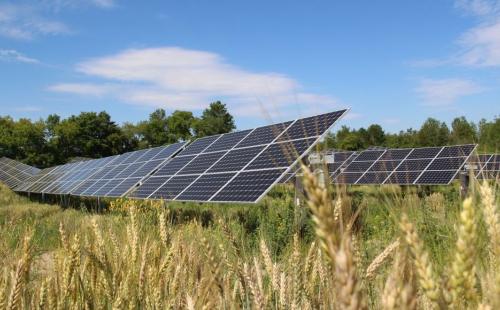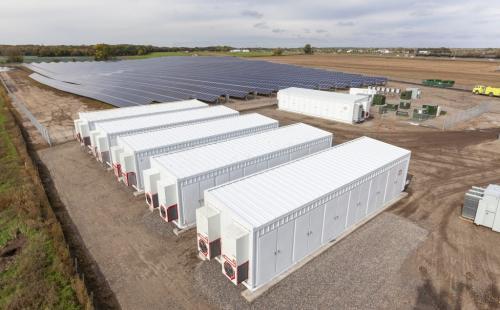The Minnesota Legislative Session is now officially in full swing, and MnSEIA is ready to advance the solar and energy storage industry at the Capitol. We're excited to work on the following policy priorities:
Community Solar Gardens
MnSEIA aims to modernize Minnesota’s community solar garden program, which is the largest in the nation with over 820 MW's of installed solar. MnSEIA is focused on three main issues:
- Removing the Contiguous County requirement - This rule requires that solar garden subscribers be located in the same county or a county contiguous (next to) to the solar project. This is an unnecessary requirement that limits subscriber choice and makes subscribing gardens more challenging for developers. Removing this restriction will help residents in the Twin Cities area access clean energy and encourage more CSG development.
- Project size increase - Increase the CSG project size from 1 MW up to 3-5 MW. The current cap unnecessarily limits project size and hinders growth of larger projects that could provide more clean energy to communities.
- Community Access plan - Establish a CSG program that focuses on residential access in exchange for transparency and consumer protection requirements.
Energy Storage
A priority for MnSEIA is to grow and accelerate the energy storage market in Minnesota. We will focus on seven areas:
- Storage interconnection standards - Direct the PUC to create standardized interconnection rules for energy storage so developers have clear guidelines to follow.
- Require storage when replacing feeders at capacity - Mandate that energy storage be used when utilities replace outdated feeders. This will help create a more resilient grid that can support more clean energy projects.
- Storage law enhancement - Strengthen 2019 energy storage legislation by requiring utilities complete storage pilot projects.
- Critical infrastructure - Require utilities to define customers that are “Critical infrastructure” and protect them with energy storage microgrids to strengthen our grid.
- ESS peak shaving discharge program - Require IOUs create a tariff for time-of-discharge rates for behind-the-meter storage to discharge at peak demand.
- Storage*Rewards - Establish a rebate program, similar to Solar*Rewards, using Renewable Development Account (RDA) money for small-scale, behind-the-meter storage in Xcel Energy territory. The Solar*Rewards program has been hugely successful in encouraging solar growth and we believe this could encourage energy storage development as well.
-
Tax status change for batteries - Change the personal property tax status for battery storage technology that is not owned or leased by utilities.
Residential Solar
This session MnSEIA will protect residential solar and expand opportunities in currently prohibited areas. MnSEIA will work on:
- Solar*Rewards - Extend the current Solar*Rewards program for an additional two years and increase funding through the Renewable Development Account (RDA). This program has been crucial to the success of the residential sector in Minnesota and its extension creates certainty and stability for developers.
- Homeowners Association moratorium - Prohibit Homeowners Associations (HOAs) from banning solar on residential properties located within an HOA. 1 in 4 Minnesotans live in an HOA and cannot access the benefits of clean energy. (MnSEIA worked on this in the 2021 Session as well, learn more here.)
- General Contractor license requirement - Mandate all solar installers obtain a general contractor license and pay into the contractor recovery fund that pays out to customers impacted by bad actors. This will improve the reputation of the solar industry and help customers.
Interconnection
Interconnection delays are a significant issue affecting solar deployment in Minnesota. MnSEIA aims to improve interconnection timelines by requiring utilities make investments in substations, transformers, and other DG infrastructure to upgrade the grid and improve its resiliency.
Utility-Scale Solar
MnSEIA wants to remove regulatory barriers to utility-scale solar projects in Minnesota to streamline project development. We aim to accomplish this by changing a rule that requires solar projects by independent power producers produce a certificate of need before obtaining construction permits.
Commercial & Industrial Solar
This session MnSEIA hopes to grow and advance the commercial and industrial (C&I) solar market. MnSEIA will focus on four areas:
- Data access practices - Allow customers to request usage and interval data. This is very useful in sizing projects and reducing demand charges.
- Solar roads & carports - Develop a program for projects that combine solar carports and EV level-2 or -3 charging ports. Also work with the Minnesota Department of Transportation (MnDOT) to implement solar snow fencing projects.
- PV Demand Credit - Require utilities outside Xcel Energy to create a PV Demand Credit tariff within their territories.
-
Solar for Schools adjustment - Amends the Solar for Schools statute to allow developers to combine Solar for Schools incentives with the PV demand credit.
Co-op Initiatives
MnSEIA aims to lay the groundwork for increasing solar in cooperative and municipal utility territory with six main initiatives:
- Size-to-load for >40kW project size - Implement a size-to-load agreement of at least 120% of load as long as the project size can be greater than 40kW.
- Clarify rates for projects >40kW - Secure an increased rate for Great River Energy co-ops that net-meter projects between 40-50 kW.
- Clarify 1-mile rule - Clarify that the 1-mile rule does not apply to DG qualifying facilities.
- Removal of cooperative solar fees - Amend 2017 legislation to drop or adjust current allowable “reasonable fee” to net-metered projects.
- Incentivize storage - Clarify that storage configured for non-export does not count toward net-metering limits, and find other ways to incentivize it.
- Solar tax credit - Allow a temporary, nonrefundable tax credit to taxpayers who install a solar energy system.
Mid-Scale Market Development
The mid-scale solar market (the size between community solar and utility-scale solar) is an important potential market for Minnesota. MnSEIA wants to grow this market by:
- Legalize the DG Tariff - The DG Tariff currently exists for each of the rate-regulated utilities, but developers cannot see what it is before they’ve applied for interconnection, which is a lengthy and expensive process. A legislative change would create the transparency needed to make these tariffs work.
- Avoided cost statutory change - A provision in the co-generation and small power production statute puts mid-market sized solar (and wind) projects at a disadvantage by forcing them to sell power at the lowest cost renewable bid that the utility has ever received. This provision, while it was originally meant to help solar and wind compete with natural gas, now means that potential 5 MW solar qualifying facilities have to compete with 250 MW wind projects sited out of state. This bill would delete this outdated and unnecessary provision.
MnSEIA's ambitious legislative agenda would not be possible without the support of our members - thank you! Stay up-to-date with our work throughout the Legislative Session by following us on Twitter.


